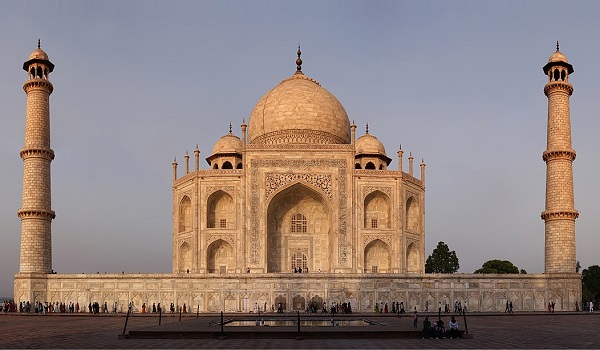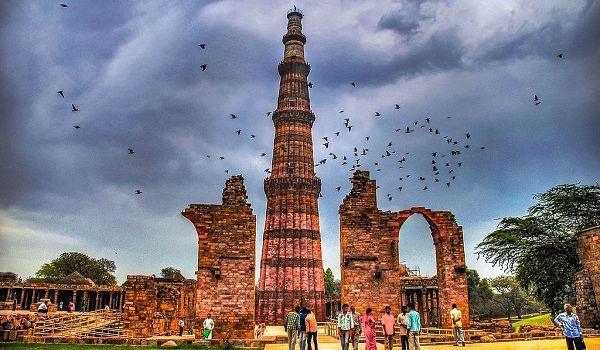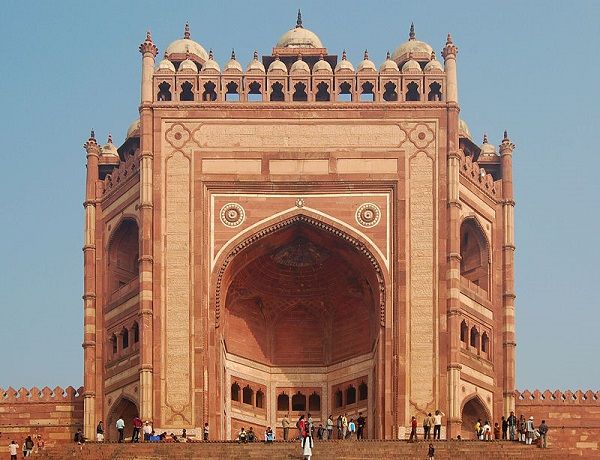
Image Source: Wikipedia.org
The medieval period saw great developments in the field of architecture in India. With the coming of Muslims to India, many new features and techniques came to be introduced in buildings. The development of Muslim Style of Architecture of this period can be called the Indo-Islamic Architecture or the Indian Architecture influenced by Islamic Art. The Indo-Islamic style was neither strictly Islamic nor strictly Hindu. It was, in fact, a combination of Islamic architecture elements to those of the Indian architecture. The architecture of the medieval period can be divided into two main categories - Architecture of the Delhi Sultanate or the Imperial Style and the Mughal Architecture. The Imperial Style developed under the patronage of the Sultans of Delhi. The Mughal Architecture was a blend of the Islamic Architecture of Central Asia and the Hindu Architecture of India.
Delhi Sultanate Architecture

Image Source: wikimedia.org
The Delhi Sultanate was predominantly spread in and around Delhi in North India and it gradually spread its rule across various parts of the Indian subcontinent for over three centuries starting from 1206 to 1526, particularly during the Tughlaq Dynasty. The rule of the sultanate comprised of five successive dynasties starting from the Mamluk Dynasty whose founder in Delhi, Qu?b al-D?n Aibak, also the founder of the Turkic dominion in north-western India, became the first sultan of Delhi. The three of the other four successive dynasties namely the Khilji Dynasty, the Tughlaq Dynasty and the Sayyid Dynasty respectively were also of Turkish origin. The last dynasty of the Delhi Sultanate was an Afghan Pashtun dynasty called the Lodi Dynasty that was founded by Bahlul Khan Lodi. The dynasty saw its fall under the reign of Ibrahim Lodi after it faced defeat at the hands of Babur, the founder of the Mughal Empire in 1526, which brought an end of the Delhi Sultanate.
During the rule of various Sultans, several politically significant Hindu temples located in enemy states were vandalised, damaged and desecrated and the development of Indo-Islamic architecture initiated. The grand and imposing edifices and monuments constructed by the Sultans of the Delhi Sultanate stand as the first illustration typifying Indo-Islamic style of architecture. A mix of Indian and Arabic styles of architecture emerged during the Delhi Sultanate that, as opined by Sir John Marshall, developed into a peerless form of art and architecture comprising of architectural brilliance of both Hindu and Muslim artisans.
Some of the unique features of architectural styles preferred by the Delhi Sultanate are palpable from their palaces that adorn elaborately decorated and embellished arches and domes. Teachings from the Holy Quran and various floral patterns are visible in the arches while swastika, lotus, bells and other Hindu motifs used widely by the sultans form parts of other embellishments of the palaces thus giving them a grand and exquisite appearance.
The Qutb Complex
The ‘Qutb Complex’ comprising of a number of historically significant monuments and buildings is one of the foremost examples of Indo-Islamic architecture. Some of the important constructions of the complex include the ‘Qutb Minar’, the ‘Quwwat-ul-Islam Mosque’, the ‘Tomb of Iltutmish’, the ‘Tomb of Imam Zamin’, the ‘Iron Pillar’ of Delhi, and Major Smith's Cupola.
‘Qutb Minar’ - The 73 m (240 ft.) colossal tower called ‘Qutb Minar’ made of red sandstone and marble located within the complex stands not only as the highest brick minaret in the world but it is also as one of the most famous tourist attractions in India. Construction of this UNESCO World Heritage Site was initiated by Qutb ud-Din Aibak, the founder of the Mamluk Dynasty in Delhi, in 1200 AD and completed by his successor and son-in-law Iltutmish in 1220 AD. This minaret was dedicated by Aibak to the Muslim Sufi mystic saint and scholar of the Chishti Order, Qutbuddin Bakhtiar Kaki.
‘Quwwat-ul-Islam Mosque’ – It is regarded as the first mosque built in India; its construction was delegated by Aibak, which started in 1193 and completed in 1197. Twenty seven Hindu temples, shafts of which adorn the inner and outer courtyard of this Jami Masjid, were demolished to construct it. A provocative inscription etched over its eastern gate justifies the presence of typical Hindu embellishments in a Muslim mosque.
‘Alai Darwaza’ - Another brilliant example of Indian and Muslim architecture is the magnificent ‘Alai Darwaza’ within the complex that forms the central gateway from the southern side of the mosque. Built in 1311 AD by Ala-ud-din Khilji, the second Khilji Sultan of the Delhi Sultanate, the gateway built of red sandstone and white marble stands as the first ever structure in India that incorporated principles of Islamic architecture, both in its construction and decoration. Unique features of Khilji art including intricate patterns and embellishments are visible from the monument.
The fortified city of Tughlaqabad built by emperor Ghiyath ud Din Tughluq; the fourth medieval city of Delhi called Jahanpanah and the ‘Adilabad Fort’ built by Muhammad bin Tughlaq, son of Ghiyath ud Din Tughluq; and the Ferozabad fort and palace constructed by Firoz Shah Tughlug, successor of Muhammad bin Tughlaq, marks the architectural style of the Tughlug dynasty.
Mughal Architecture

Image Source: wikimedia.org
The Mughal Empire was founded in the Indian subcontinent by a conqueror from Central Asia called Babur who became the first Mughal emperor in India in 1526. The Mughal Empire that ruled till 1764 in India made significant contribution in the field of architecture in the Indian subcontinent by evolving a rich and unique architectural style, better known as Mughal architecture that portray a fine blend of Central Asian, Islamic, Persian, Arabic and Turkish architectural styles with that of the native architectural styles of India.
The symmetrical design palpable from the monuments, buildings and courtyards built during the Mughal reign forms one of the central features of Mughal architecture. This is more discernable from the symmetrically designed towns and forts built by Akbar, the great Mughal emperor of the 16th century. Akbar made significant contributions to the Mughal style of architecture. Huge domes bulbaceous in shape, large halls, colossal gateways, svelte minarets positioned at corners and fine embellishments are some of the other signature features of the Mughal architecture.
The Mughal emperors, particularly Shah Jahan, were connoisseurs of art and architecture that manifested into several grand and imposing monuments, palaces, forts, Masjids and tombs among others built during their era including the world famous ivory white marble mausoleum, the Taj Mahal. The Mughal architecture reached its peak during the rule of Shah Jahan who, apart from the Taj Mahal, is accredited for constructing other majestic and architectural splendours like the ‘Red Fort’, the ‘Jama Masjid’ and the ‘Shalimar Gardens’.
The marvels of Mughal architecture are spread over Delhi, Agra, Fatehpur Sikri, Aurangabad, Jaipur and many other cities in present day India and other cities like Lahore and Sheikhupura in Pakistan, Dhaka in Bangladesh and Kabul in Afghanistan. Some of the significant and most popular ones include the ‘Taj Mahal’, ‘Red Fort’, the ‘Agra Fort’, ‘Fatehpur Sikri’, ‘Akbar’s Tomb’, ‘Humayun’s Tomb’, the ‘Jama Masjid’ and the ‘Badshahi Masjid’ among others.
Let us take a look at some of the marvels of the Mughal style of architecture in India:
‘Taj Mahal’
Built as a tomb by Shah Jahan for his beloved Queen Mumtaz Mahal, this elegant and grand mausoleum situated on the south bank of the river Yamuna in Agra, India, is perhaps the finest testament of the Mughal architecture. It not only stands as an epitome of love attracting millions of visitors round the year but it is also as a UNESCO World Heritage Site and one of the 7 Wonders of the World.
‘Red Fort’
Built as a palace by Emperor Shah Jahan in 1639, this historically significant fort situated in Delhi, India, remained the central residence of the Mughal emperors for around two centuries till 1857 apart from serving as an important political and ceremonial centre of the dynasty. This UNESCO World Heritage Site that holds a special significance and pride in the history and culture of India and attracts several tourists all year round comes to life especially on the Independence Day of India. Every year, the Indian Prime Minister hoists the country’s flag at the central gate of the fort on August 15.
‘Fatehpur Sikri’
One of the architectural gems of the Mughal Empire is the city of ‘Fatehpur Sikri’ located in the Agra District of Uttar Pradesh, India. Built by Emperor Akbar as his Capital City from 1569 AD to 1574 AD, the city served its purpose from 1571 to 1585 and comprised of several edifices that were significant both in terms of religion and secularism.
Some of the important buildings and constructions within the city are the 15-storied high semi octagonal gateway called ‘Buland Darwaza’, also referred as the ‘Gate of Magnificence’ that forms the main entrance to the palace of the city portraying a remarkable blend of Hindu and Persian styles of architecture; the ‘Jama Masjid’ also referred as the ‘Friday Mosque’ reflecting Iranian architecture in some of its designs; and the ‘Tomb of Salim Chisti’ housing the grave of the Sufi saint Salim Chisti.



